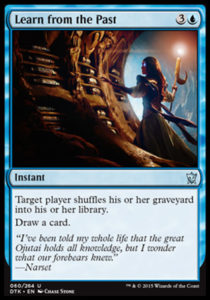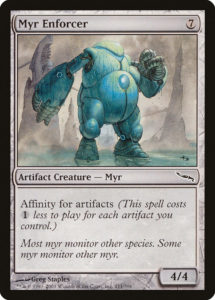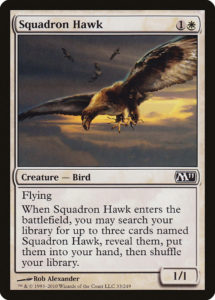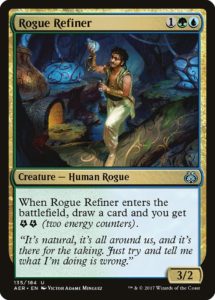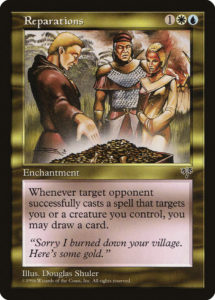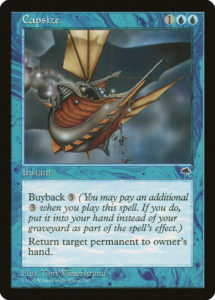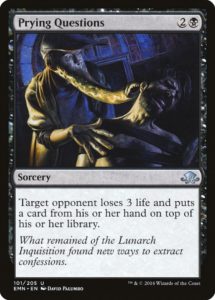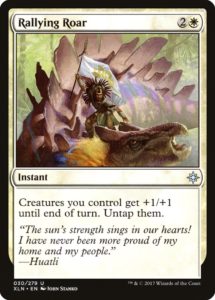Magic is firmly in a new era. For the moment let’s set aside the pandemic, the curtailment of LGS play, the temporary conclusion of all paper tournaments, and the often less-than-polite discussion around Double Masters. Let’s focus on one thing: Standard bannings.
Two cards were banned in Standard yesterday and for the first time—ever?—a brand new mechanic was modified (to nerf Companion). A card being banned in Standard is remarkable enough, but it’s less noteworthy today than it has been historically. Let’s look backwards to see what history teaches us about Standard’s present.
Lulls and Bursts
In 1999, six years after Magic’s creation, Dream Halls, Earthcraft, Fluctuator, Lotus Petal, Recurring Nightmare, Time Spiral, Memory Jar, and Mind Over Matter were banned from Standard (then called Type 2). Eight cards culled from Urza’s block Standard, one of the most bah-roken periods in Magic, a time when R&D was chewed out for creating these cards.
From 2000-2004, no cards were banned in Standard, pretty impressive considering Magic almost doubled in popularity during this period.
In 2004, Skullclamp was banned, the herald of a major problem on Mirrodin.
In 2005, Arcbound Ravager, Disciple of the Vault, Ancient Den, Seat of the Synod, Vault of Whispers, Great Furnace, Tree of Tales, and Darksteel Citadel were banned, ending the dominance of Ravager Affinity.
From 2006-2010, no cards were banned in Standard.
In 2011, Jace, the Mind Sculptor and Stoneforge Mystic were banned. Both were overpowered cards dealing with relatively new card types (planeswalkers and equipment).
From 2012-2016, no cards were banned in Standard. This was the third and final four year lull between momentous bannings.
In 2017, a new era began with five Standard bans. The power level of Standard was lowered (especially that of interaction), making it easier for overly pushed threats to dominate. Emrakul, the Promised End, Smuggler’s Copter, and Reflector Mage were banned for their efficiency. Felidar Guardian was banned for its accidentally overpowered ETB effect. Aetherworks Marvel was banned for undermining the mana system and creating frustrating, redundant play patterns.
2018 opened with four bannings: Attune with Aether, Rogue Refiner, Ramunap Ruins, and Rampaging Ferocidon. Energy was overpowered and uninteractive, as was Mono-Red aggro (and Mardu Vehicles). After a tumultuous January, it finally looked like things had calmed down and we might return to another lull.
2019 shattered these hopes. After a year’s pause, Field of the Dead, Oko, Thief of Crowns, Once Upon a Time, and Veil of Summer were banned, with Nexus of Fate being banned in best-of-one Arena. That’s four or five bannings in a year (depending on how you count), which has become the standard for Standard.
2020 is not yet halfway done. It’s been an absolute doozy of a year for various non-Magic reasons, but yesterday we hit the halfway point for expected annual bans with Fires of Invention and Agent of Treachery. In addition, 10 cards were nerfed as the Companion mechanic was retroactively changed in a complete Magic first.
From 2017-2020, fifteen cards have been banned. From 2000-2016, 10 cards were banned. This has been accompanied by a shift in how Wizards of the Coast discusses bannings.
R&D’s Disposition
When Skullclamp was banned, Aaron Forsythe apologized profusely, saying, “We’re sorry that your faith in us—the whole development process—has been shaken.” For one banned card.
When eight cards were banned the following year, he spoke on the danger of bannings on the whole: “We like to avoid having to solve problems by banning cards, as that leads to a culture of fear. We certainly don’t want people to start believing that all the good cards they own are in the crosshairs of the DCI.”
In the 2011 bannings, he talked about the pain that bannings inflict:
“We don’t take banning lightly in any format, and we loathe doing it in Standard. Not only is such an act tantamount to the admission of grievous mistakes on our part, it hurts consumer confidence in our product. People spend a lot of time and money acquiring cards for their tournament decks, and it stings to have them taken away.”
Things are quite different today, now that Arena exists. Digital cards are much cheaper than physical cards, the internet accelerates formats getting solved, and for the time being all competitive play exists online. When three cards were banned last Fall, Play Design’s accompanying article said that while the banned cards were unintentionally much too strong, Throne of Eldraine was merely at the high end of intended power level. They’d erred, but there wasn’t a need for a course correction. Wizards continued printing hard-hitting cards for nonrotating formats in Theros Beyond Death, getting one set’s reprieve before having to institute more bans. Yesterday’s article by Ian Duke acknowledged the latest imbalances in Standard and with Companion’s design, made changes—and that was it.
Now, I don’t believe that Ian Duke ought to be saying mea culpa. Design is a messy thing and none of these bannings are his fault. And balancing Magic is hard. Even the best minds in the world will either push things too hard and necessitate bannings, or worse, not push them enough and depress sales; so it’s best to err on the side of making things too strong. But the discourse around bannings stands in stark contrast to how it used to be. Once, bannings were considered to damage Magic’s brand. Now they’re normalized, and that’s concerning.
The Cost of Bans
Once upon a time, bannings were tragic and seen as dangerous to consumer confidence. Why should people buy into the new set, or Magic as a whole, when hundreds of dollars of cardboard could lose their financial and play value out of nowhere? Why incur that risk when other games are so much cheaper to play? We’ve gone from Magic only banning cards at specified times each quarter to being able to ban them with a week’s notice because cards now regularly need to be banned.
If you’re an Arena player, this might not be a problem. It’s pretty cheap to build an entirely new deck, even if four (or more!) cards are banned annually. But Magic is fundamentally a physical game and makes a large portion of its money from physical product sales. Well, the pandemic prevents me from playing with physical boosters, and the increased volatility of every Magic format means there’s a chance there won’t be much within boosters that I can play with when the world settles into a healthier, hopefully more equitable future. So why should I buy Magic products other than to support my local game store? That’s becoming a harder question to answer.
Will things change?
Let’s cycle back to how R&D talks about bans. Announcements like yesterday’s discuss the problems necessitating bans, but avoid discussing why the cards are problematic in the first place. It leaves one wondering whether they consider Fires of Invention an anomaly or a canary in the coal mine. Does it make Play Design think differently about making more cards like Wilderness Reclamation, or is it a card they feel comfortable reprinting or iterating on? I’d love to know their thoughts on the matter.
It’s important for players to understand some part of how Wizards of the Coast perceives bannings. They ought not to share their design processes or the little changes that broke these cards or weakened their answers, and they absolutely should not single out any employees involved in their creation. But if we don’t perceive R&D as learning from these mistakes or even seeing them as mistakes, how can we not assume we’ll see more such preventable mistakes?
Rogue Refiner demonstrated just how dangerous it is to tack on “draw a card” without increasing a mana cost, and then Veil of Summer repeated the mistake.
Ramunap Ruins showed that lands with game-winning effects for minimal costs and with minimal means of disruption are dangerous. Then we got Field of the Dead.
Aetherworks Marvel demonstrated the danger of repetitive play patterns and that looking six cards deep is closer to tutoring than it is randomness. And we now have both Companions and Winota, Joiner of Forces.
Felidar Guardian had an unintentionally busted ETB effect, as does Agent of Treachery.
Magic is hard to make and mistakes tend to involve power level, card draw, and mana. I could be splitting hairs with these comparisons, but I’m concerned that Wizards isn’t seeing Standard bans as the catastrophes to reflect on they once did. Perhaps bannings aren’t damaging as they once believed, but they now seem to be treated as inevitable rather than avoidable.
Looking Ahead
Right now, I’m very upset and most of those feelings have nothing to do with Magic. I hate being cooped up inside, afraid of infecting or being infected by everyone I see, and denied all the connections that make me love living in New York City. I hate seeing injustice in the nation, and while I appreciate learning more about my own privilege and how I can help, it’s nevertheless deeply upsetting seeing so much violence, hate, and idiocy. I’m upset normal coping activities, like hanging out with my friends and playing Magic, are unavailable for the foreseeable future. Those emotions color this article and I acknowledge that.
But I am concerned. I’m confident that Magic will survive Covid-19, that tournament play will eventually return, and that players will once again safely congregate at tables without masks. But I’m worried that this could be a much smaller Magic, one dominated by power creep and bankrolled by ultra-premium products—rather than the best game in the world, one which earns the respect of and is respected by its players (who nevertheless complain out of love). I know that those who work on Magic cherish it and the decision to ban cards weighs heavily on them. But I want to understand how they perceive the state of bannings.
I want to learn about the processes that led to Companions when its precursor mechanics proved so problematic, both in Avaycn Restored’s unused Forbidden mechanic and in Mark Rosewater’s first design lead, Tempest:
“My idea was for a series of cards that if you put them in your deck, you could just choose to have them in your opening hand. The cost was that you’d have to draw one less card at the start of the game. Also, the cards were a little weaker than a normal card… It turns out I broke a rule that just shouldn’t ever be broken. These cards were so insanely overpowered (or in R&D slang “bah-roken”) that I figured it out without even needing a playtest. …no variance between games, no suspense—you know, just chuck everything that makes Magic actually fun. I had somehow managed to break one of the things that made trading card games work.”
I’m not saying Companion should never have been made, or that Wizards today isn’t doing better work than the much smaller and less experienced R&D of the mid-90s. But I’m worried that lessons of the past are being forgotten or ignored and that individual cards being unintentionally strong is seen as the problem, rather than the processes that designed them. I adore Magic and want it to continue to thrive, but it hurts seeing the game look like it’s hurting itself.
Here’s hoping we’ll get to read more about how Wizards perceives these bannings and whether four annual bannings is now considered acceptable. Until then, here’s hoping it’ll be safe to sling real cardboard sooner than later and that the game will find a new balance.
And, as always, thanks for reading.
—Zachary Barash is a New York City-based game designer and the commissioner of Team Draft League. He designs for Kingdom Death: Monster, has a Game Design MFA from the NYU Game Center, and does freelance gatame design. When the stars align, he streams Magic (but the stars align way less often than he’d like).

